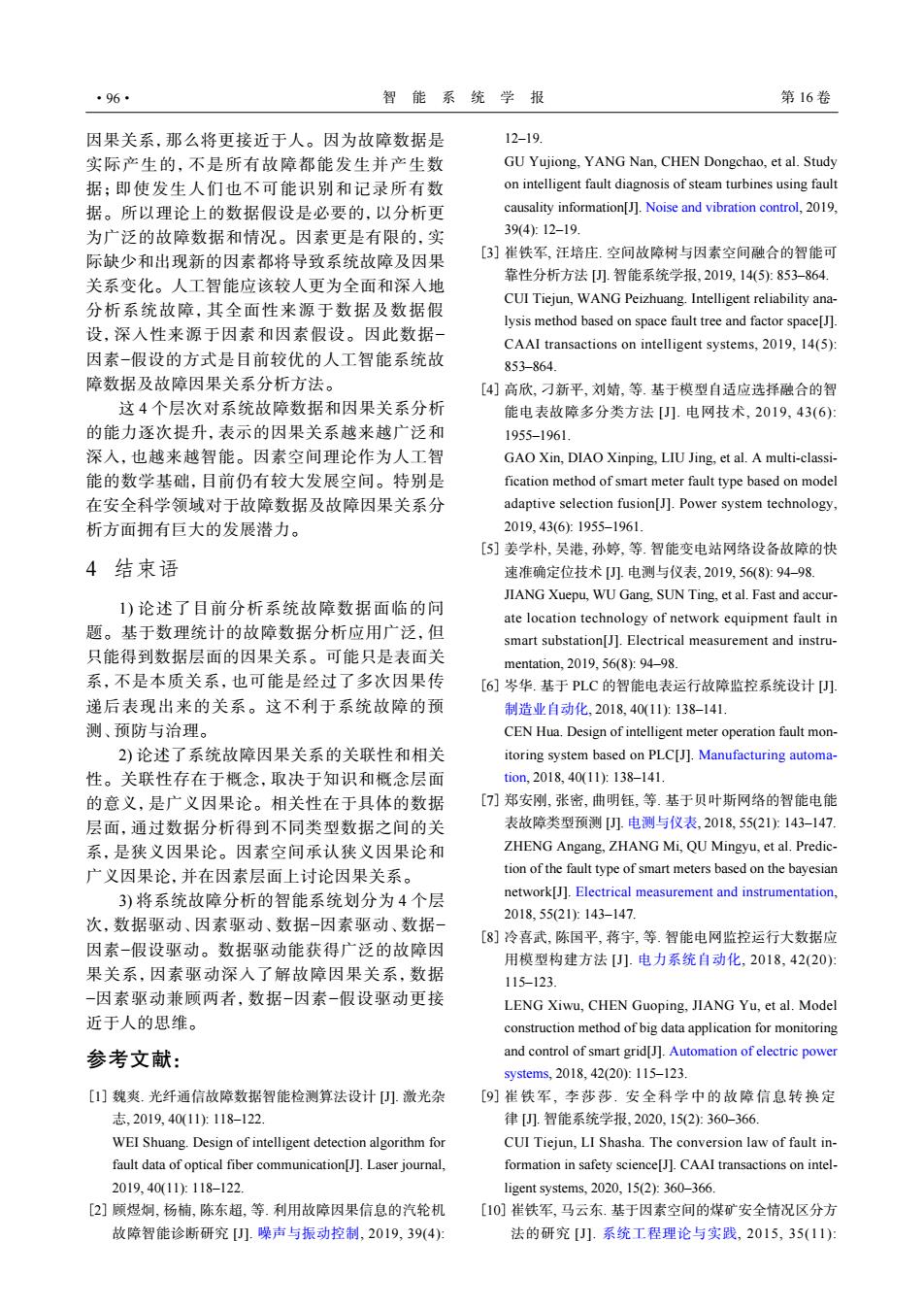正在加载图片...

·96· 智能系统学报 第16卷 因果关系,那么将更接近于人。因为故障数据是 12-19 实际产生的,不是所有故障都能发生并产生数 GU Yujiong,YANG Nan,CHEN Dongchao,et al.Study 据;即使发生人们也不可能识别和记录所有数 on intelligent fault diagnosis of steam turbines using fault 据。所以理论上的数据假设是必要的,以分析更 causality information[J].Noise and vibration control,2019, 为广泛的故障数据和情况。因素更是有限的,实 39(4):12-19. 际缺少和出现新的因素都将导致系统故障及因果 [3]崔铁军,汪培庄.空间故障树与因素空间融合的智能可 关系变化。人工智能应该较人更为全面和深入地 靠性分析方法[).智能系统学报,2019,14(5):853-864. CUI Tiejun,WANG Peizhuang.Intelligent reliability ana- 分析系统故障,其全面性来源于数据及数据假 lysis method based on space fault tree and factor space[J]. 设,深入性来源于因素和因素假设。因此数据- CAAI transactions on intelligent systems,2019,14(5): 因素-假设的方式是目前较优的人工智能系统故 853-864. 障数据及故障因果关系分析方法。 [4]高欣,刁新平,刘婧,等.基于模型自适应选择融合的智 这4个层次对系统故障数据和因果关系分析 能电表故障多分类方法[J】.电网技术,2019,43(6): 的能力逐次提升,表示的因果关系越来越广泛和 1955-1961. 深人,也越来越智能。因素空间理论作为人工智 GAO Xin,DIAO Xinping,LIU Jing,et al.A multi-classi- 能的数学基础,目前仍有较大发展空间。特别是 fication method of smart meter fault type based on model 在安全科学领域对于故障数据及故障因果关系分 adaptive selection fusion[J].Power system technology, 析方面拥有巨大的发展潜力。 2019,43(6):1955-1961 [5]姜学朴,吴港,孙婷,等.智能变电站网络设备故障的快 4结束语 速准确定位技术1.电测与仪表,2019,56(8):94-98. JIANG Xuepu,WU Gang,SUN Ting,et al.Fast and accur- 1)论述了目前分析系统故障数据面临的问 ate location technology of network equipment fault in 题。基于数理统计的故障数据分析应用广泛,但 smart substation[J].Electrical measurement and instru 只能得到数据层面的因果关系。可能只是表面关 mentation,.2019,56(8:94-98. 系,不是本质关系,也可能是经过了多次因果传 [6]岑华.基于PLC的智能电表运行故障监控系统设计 递后表现出来的关系。这不利于系统故障的预 制造业自动化,2018,40(11)少138-141. 测、预防与治理。 CEN Hua.Design of intelligent meter operation fault mon- 2)论述了系统故障因果关系的关联性和相关 itoring system based on PLC[J].Manufacturing automa- 性。关联性存在于概念,取决于知识和概念层面 tion,2018,40(11):138-141. 的意义,是广义因果论。相关性在于具体的数据 [7]郑安刚,张密,曲明钰,等.基于贝叶斯网络的智能电能 层面,通过数据分析得到不同类型数据之间的关 表故障类型预测).电测与仪表,2018,55(21)上143-147. 系,是狭义因果论。因素空间承认狭义因果论和 ZHENG Angang,ZHANG Mi,QU Mingyu,et al.Predic- 广义因果论,并在因素层面上讨论因果关系。 tion of the fault type of smart meters based on the bayesian 3)将系统故障分析的智能系统划分为4个层 network[J.Electrical measurement and instrumentation, 次,数据驱动、因素驱动、数据-因素驱动、数据 2018,55(21)143-147 [8]冷喜武,陈国平,蒋字,等.智能电网监控运行大数据应 因素-假设驱动。数据驱动能获得广泛的故障因 用模型构建方法].电力系统自动化,2018,42(20): 果关系,因素驱动深入了解故障因果关系,数据 115-123 -因素驱动兼顾两者,数据-因素-假设驱动更接 LENG Xiwu,CHEN Guoping,JIANG Yu,et al.Model 近于人的思维。 construction method of big data application for monitoring 参考文献: and control of smart grid.Automation of electric power systems,2018,42(20):115-123. [1]魏爽.光纤通信故障数据智能检测算法设计.激光杂 [9]崔铁军,李莎莎.安全科学中的故障信息转换定 志,2019,40(11)118-122 律[).智能系统学报,2020,15(2):360-366. WEI Shuang.Design of intelligent detection algorithm for CUI Tiejun,LI Shasha.The conversion law of fault in- fault data of optical fiber communication[J].Laser journal, formation in safety science[J].CAAI transactions on intel- 2019,40(11)118-122 ligent systems,2020,15(2):360-366. [2]顾煜炯,杨楠,陈东超,等.利用故障因果信息的汽轮机 [10]崔铁军,马云东.基于因素空间的煤矿安全情况区分方 故障智能诊断研究.噪声与振动控制,2019,39(4): 法的研究[].系统工程理论与实践,2015,35(11):因果关系,那么将更接近于人。因为故障数据是 实际产生的,不是所有故障都能发生并产生数 据;即使发生人们也不可能识别和记录所有数 据。所以理论上的数据假设是必要的,以分析更 为广泛的故障数据和情况。因素更是有限的,实 际缺少和出现新的因素都将导致系统故障及因果 关系变化。人工智能应该较人更为全面和深入地 分析系统故障,其全面性来源于数据及数据假 设,深入性来源于因素和因素假设。因此数据− 因素−假设的方式是目前较优的人工智能系统故 障数据及故障因果关系分析方法。 这 4 个层次对系统故障数据和因果关系分析 的能力逐次提升,表示的因果关系越来越广泛和 深入,也越来越智能。因素空间理论作为人工智 能的数学基础,目前仍有较大发展空间。特别是 在安全科学领域对于故障数据及故障因果关系分 析方面拥有巨大的发展潜力。 4 结束语 1) 论述了目前分析系统故障数据面临的问 题。基于数理统计的故障数据分析应用广泛,但 只能得到数据层面的因果关系。可能只是表面关 系,不是本质关系,也可能是经过了多次因果传 递后表现出来的关系。这不利于系统故障的预 测、预防与治理。 2) 论述了系统故障因果关系的关联性和相关 性。关联性存在于概念,取决于知识和概念层面 的意义,是广义因果论。相关性在于具体的数据 层面,通过数据分析得到不同类型数据之间的关 系,是狭义因果论。因素空间承认狭义因果论和 广义因果论,并在因素层面上讨论因果关系。 3) 将系统故障分析的智能系统划分为 4 个层 次,数据驱动、因素驱动、数据−因素驱动、数据− 因素−假设驱动。数据驱动能获得广泛的故障因 果关系,因素驱动深入了解故障因果关系,数据 −因素驱动兼顾两者,数据−因素−假设驱动更接 近于人的思维。 参考文献: 魏爽. 光纤通信故障数据智能检测算法设计 [J]. 激光杂 志, 2019, 40(11): 118–122. WEI Shuang. Design of intelligent detection algorithm for fault data of optical fiber communication[J]. Laser journal, 2019, 40(11): 118–122. [1] 顾煜炯, 杨楠, 陈东超, 等. 利用故障因果信息的汽轮机 故障智能诊断研究 [J]. 噪声与振动控制, 2019, 39(4): [2] 12–19. GU Yujiong, YANG Nan, CHEN Dongchao, et al. Study on intelligent fault diagnosis of steam turbines using fault causality information[J]. Noise and vibration control, 2019, 39(4): 12–19. 崔铁军, 汪培庄. 空间故障树与因素空间融合的智能可 靠性分析方法 [J]. 智能系统学报, 2019, 14(5): 853–864. CUI Tiejun, WANG Peizhuang. Intelligent reliability analysis method based on space fault tree and factor space[J]. CAAI transactions on intelligent systems, 2019, 14(5): 853–864. [3] 高欣, 刁新平, 刘婧, 等. 基于模型自适应选择融合的智 能电表故障多分类方法 [J]. 电网技术, 2019, 43(6): 1955–1961. GAO Xin, DIAO Xinping, LIU Jing, et al. A multi-classification method of smart meter fault type based on model adaptive selection fusion[J]. Power system technology, 2019, 43(6): 1955–1961. [4] 姜学朴, 吴港, 孙婷, 等. 智能变电站网络设备故障的快 速准确定位技术 [J]. 电测与仪表, 2019, 56(8): 94–98. JIANG Xuepu, WU Gang, SUN Ting, et al. Fast and accurate location technology of network equipment fault in smart substation[J]. Electrical measurement and instrumentation, 2019, 56(8): 94–98. [5] 岑华. 基于 PLC 的智能电表运行故障监控系统设计 [J]. 制造业自动化, 2018, 40(11): 138–141. CEN Hua. Design of intelligent meter operation fault monitoring system based on PLC[J]. Manufacturing automation, 2018, 40(11): 138–141. [6] 郑安刚, 张密, 曲明钰, 等. 基于贝叶斯网络的智能电能 表故障类型预测 [J]. 电测与仪表, 2018, 55(21): 143–147. ZHENG Angang, ZHANG Mi, QU Mingyu, et al. Prediction of the fault type of smart meters based on the bayesian network[J]. Electrical measurement and instrumentation, 2018, 55(21): 143–147. [7] 冷喜武, 陈国平, 蒋宇, 等. 智能电网监控运行大数据应 用模型构建方法 [J]. 电力系统自动化, 2018, 42(20): 115–123. LENG Xiwu, CHEN Guoping, JIANG Yu, et al. Model construction method of big data application for monitoring and control of smart grid[J]. Automation of electric power systems, 2018, 42(20): 115–123. [8] 崔铁军 , 李莎莎 . 安全科学中的故障信息转换定 律 [J]. 智能系统学报, 2020, 15(2): 360–366. CUI Tiejun, LI Shasha. The conversion law of fault information in safety science[J]. CAAI transactions on intelligent systems, 2020, 15(2): 360–366. [9] 崔铁军, 马云东. 基于因素空间的煤矿安全情况区分方 法的研究 [J]. 系统工程理论与实践, 2015, 35(11): [10] ·96· 智 能 系 统 学 报 第 16 卷